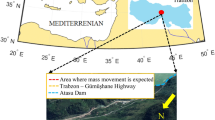Abstract
Nowadays, deformation monitoring survey includes numerous tasks, for example monitoring of engineering structures such as dam and bridges, land subsidence, earthquakes and other related applications. As a result, many professional groups such as surveyors and structural engineers, besides geophysics and geologists study the deformation analysis as a rigorous subject. Deformation measurements and analysis using geodetic method is one of the complicated and challenging works that need to be undertaken by land surveyors. The result of deformation analysis is to be used by other professions such as engineers, geodesists and geophysics as well. However, they are not really interested in the geometrical analysis (i.e. coordinate difference). Actually, they required the result of deformation modelling which is the deformation parameter that related to their field of study. Here shows the importance of information on deformation modelling instead of geometrical analysis and when its need to be performed. This study focused on the development of deformation modelling computational routine and subsequently been incorporated into an existing deformation analysis package. Deformation modelling is the stage to produce the right mathematical model from the result of deformation analysis (trend analysis) with relevant deformation parameter. The computational routine developed to analyse survey data obtained by the conventional geodetic technique in 2 dimension. In order to do deformation analysis, MATLAB program has been used to solve all the computation process. As a result, the ‘best’ model has been selected among the five models tested. The best model showed what type of deformation occurs on the body of the simulation network. The outcomes of the research have also improved from previous software and the results obtained were good and practicable to this study.
Access this chapter
Tax calculation will be finalised at checkout
Purchases are for personal use only
Similar content being viewed by others
References
Caspary, W.F.: Concepts of Network and Deformation Analysis, 1st edn. Monograph 11, School of Surveying, The University of New South Wales, Australia (1987)
Kuang, S.: Geodetic Network Analysis and Optimal Design: Concept and Applications. Ann Arbor Press Inc, Chelsea, Michigan (1996)
Ogundare, J.O.: Deformation monitoring and analysis. Geodetic techniques. In: Precision Surveying, The Principles and Geomatics Practice. Wiley, Hoboken, NJ, USA (2015)
Xiongyao, X., Xiaozhi, L.: Development of a 3D modelling algorithm for tunnel deformation monitoring based on terrestrial laser scanning. In: Underground Space. Department of Geotechnical Engineering, Tongji University, Shanghai, China (2017)
Setan, H., Singh, R.: Deformation Analysis of a Geodetic Monitoring Network. Center for Industrial Measurement and Engineering Surveying, Universiti Teknologi Malaysia (2001)
Setan, H.: Functional and stochastic models for geometrical detection of spatial deformation in engineering: a practical approach, Ph.D. Thesis. Department of Civil Engineering, City University, London (1995)
Singh, R.: Analisis Deformasi 2-D dengan kaedah Ujian Kongruensi. Bachelor Degree Project, Faculty of Geoinformation Science and Engineering, Universiti Teknologi Malaysia, Johor Bahru (1997)
Aisyah, R.: The Trend Analysis of Geodetic Monitoring Network by Use of Robust S-Transformation method. Bachelor Degree Project, Faculty of Geoinformation and Real Estate. Universiti Teknologi Malaysia (2014)
Ghilani, C.D., Wolf, P.R.: Adjustment Computations. Wiley, New York (2006)
Setan, H.: An Optimal Solution for Managing the Deformation Behavior of Engineering Structures. Pusat Pengurusan Penyelidikan, Universiti Teknologi Malaysia (2006)
Rosly, A.: Development of an Extended Version of Fredy03 Software for Deformation Analysis. Bachelor Degree Project, Faculty of Geoinformation and Real Estate, Universiti Teknologi Malaysia (2011)
Jafari, M.: Deformation modelling of structures enriched by inter-element continuity condition based on multi-sensor data fusion. Appl. Math. Model. 40(21–22), 9316–9326 (2016)
Zainal, A.M.S.: Deformation Survey. Lecture Note Faculty of Geoinformation and Real Estate. Universiti Teknologi Malaysia (Unpublished) (2016)
Chen, Y.Q.: Analysis of deformation surveys—a generalized method. Technical Report No. 94. Department of Surveying Engineering, University of New Brunswick, Fredericton, N.B (1983)
Majudi, N.: Pemilihan model deformasi bagi jaringan geodetik. Projek Sarjana Muda, Fakulti Geinformasi dan Harta Tanah, Universiti Teknologi Malaysia (1999)
Chrzanowski, A.: Geotechnical and other non-geodetic methods in deformation measurements. In: Proceedings of the Deformation Measurement Workshop, pp. 112–153. Boston, Massachusetts, 31 November, Massachusetts Institute of Technology, Cambridge, M.A. (1986)
Kamiński, W., Nowel, K.: Local variance factors in deformation analysis of non-homogenous monitoring networks. Surv. Rev. 45(328), 44–50 (2013)
Acknowledgements
The authors would like to express gratitude to the Malaysian Ministry of Education (MOE) and Universiti Teknologi Malaysia for funding this research under Research University Grant (Vot Number: Q.J130000.2527.11H08).
Author information
Authors and Affiliations
Corresponding author
Editor information
Editors and Affiliations
Rights and permissions
Copyright information
© 2019 Springer Nature Singapore Pte Ltd.
About this paper
Cite this paper
Bidi, N.K., Som, Z.A.M., Din, A.H.M., Omar, A.H. (2019). The Development of Computational Routine for Deformation Modelling and Analysis: A Case for Two-Dimensional Geodetic Technique. In: Pradhan, B. (eds) GCEC 2017. GCEC 2017. Lecture Notes in Civil Engineering , vol 9. Springer, Singapore. https://doi.org/10.1007/978-981-10-8016-6_54
Download citation
DOI: https://doi.org/10.1007/978-981-10-8016-6_54
Published:
Publisher Name: Springer, Singapore
Print ISBN: 978-981-10-8015-9
Online ISBN: 978-981-10-8016-6
eBook Packages: EngineeringEngineering (R0)




